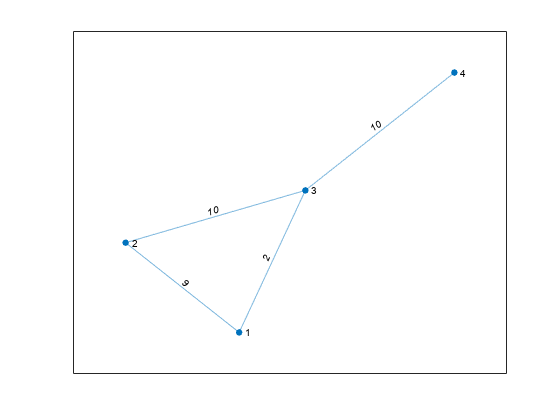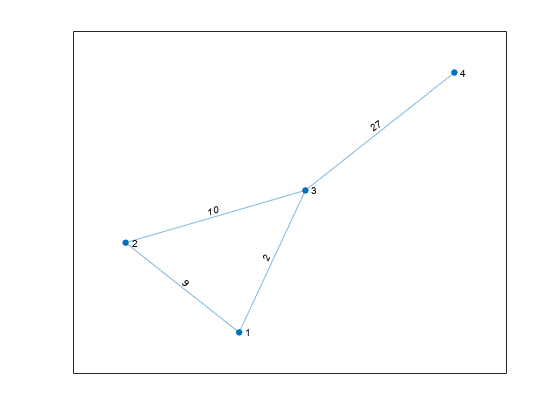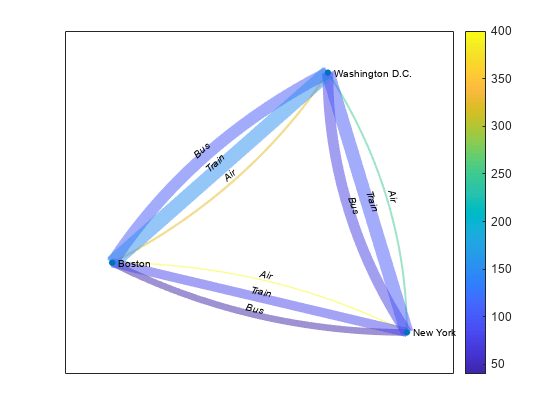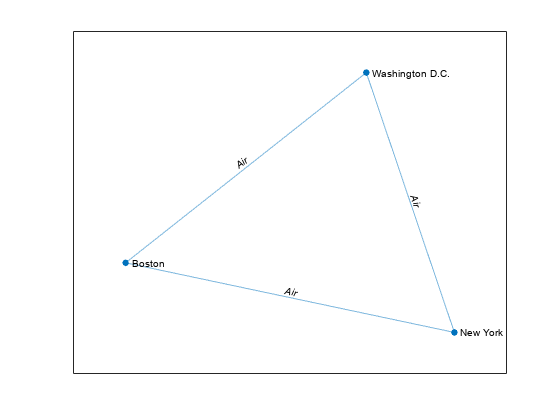simplify
将多重图简化为简单图
语法
说明
H = simplify(G,pickmethod)pickmethod 可以是 'first'(默认值)、'last'、'min' 或 'max'。
H = simplify(G,aggregatemethod)G 中所有其他边属性均舍弃。aggregatemethod 可以是 'sum' 或 'mean'。
H = simplify(___,selfloopflag)'keepselfloops' 指定具有一个或多个自环的节点在简化图中将只有一个自环。
H = simplify(___,Name,Value)G.Edges 中指定 'PickVariable' 和一个变量,将该变量与 'min' 或 'max' 选择方法一起使用。
示例
创建一个加权的无向多重图,在节点 1 和节点 2 之间有多条边。
G = graph([1 1 1 1 2 3],[2 2 2 3 3 4], 1:6); G.Edges
ans=6×2 table
EndNodes Weight
________ ______
1 2 1
1 2 2
1 2 3
1 3 4
2 3 5
3 4 6
将多重图简化为简单图,使节点 1 和节点 2 之间只有一条边。simplify 保留这两个节点之间的第一条边 G.Edges(1,:) 并舍弃其他边。
G = simplify(G); G.Edges
ans=4×2 table
EndNodes Weight
________ ______
1 2 1
1 3 4
2 3 5
3 4 6
使用 simplify 的第二个输入选择一种方法:是从多条边之中进行选择,还是将多条边合并成一条边。
创建一个加权的多重图。在此图中,节点 3 和节点 4 之间出现五条边,但边的权重是随机的。查看边表并绘制该图作为参考。
G = graph([1 2 3 3 3 3 3 3 ],[2 3 1 4 4 4 4 4],randi(10,1,8)); G.Edges
ans=8×2 table
EndNodes Weight
________ ______
1 2 9
1 3 2
2 3 10
3 4 10
3 4 7
3 4 1
3 4 3
3 4 6
plot(G,'EdgeLabel',G.Edges.Weight)
命令 simplify(G) 保留重复边中的第一条边。但是,您可以使用第二个输入指定不同的选择/合并方法。
从多条边之中进行选择的选项包括:'first'(默认值)、'last'、'min' 和 'max'。保留权重最大的重复边。
H_pick = simplify(G,'max'); plot(H_pick,'EdgeLabel',H_pick.Edges.Weight)

将多条边合并成一条边的选项包括:'sum' 和 'mean'。将重复边相加生成一条权重较大的边。
H_comb = simplify(G,'sum'); plot(H_comb,'EdgeLabel',H_comb.Edges.Weight)

使用 'keepselfloops' 选项在简化图的同时保留自环。
创建一个具有两个节点和几个自环的多重图。简化图并保留自环。
G = graph([1 1 1 1 1 1 1 2 2 2 2],[1 1 1 1 2 2 2 2 2 2 2 ]);
plot(G)
axis equal
G = simplify(G,'keepselfloops'); plot(G) axis equal

使用 simplify 的第二个和第三个输出,获取有关合并了多少条边(以及哪些边)的信息。
创建一个具有三个节点和四条边的无向多重图。
G = graph([1 1 1 2],[2 2 3 3]); G.Edges
ans=4×1 table
EndNodes
________
1 2
1 2
1 3
2 3
简化图并指定三个输出,以获取有关合并边的更多信息。
[G,ei,ec] = simplify(G)
G =
graph with properties:
Edges: [3×1 table]
Nodes: [3×0 table]
ei = 4×1
1
1
2
3
ec = 3×1
2
1
1
ei(i) 是简化图中表示旧图中的边 i 的边。由于前两条边重复,因此 ei(1) = ei(2) = 1。而且 ec(1) = 2,因为新图中有两条边对应于旧图中的边 1。
说明如何使用 'PickVariable' 和 'AggregationVariables' 名称-值对组来简化多重图。
创建一个多重图,其中的节点表示位置,边表示运输方式。边的属性反映每一种运输方式的成本和时间。预览边表。
G = graph([1 1 1 1 1 1 2 2 2],[2 2 2 3 3 3 3 3 3],[],{'New York', 'Boston', 'Washington D.C.'});
G.Edges.Mode = categorical([1 2 3 1 2 3 1 2 3],[1 2 3],{'Air' 'Train' 'Bus'})';
G.Edges.Cost = [400 80 40 250 100 75 325 150 100]';
G.Edges.Time = [1 7 5 1.5 10 8 1.75 11 9]';
G.Edgesans=9×4 table
EndNodes Mode Cost Time
___________________________________ _____ ____ ____
{'New York'} {'Boston' } Air 400 1
{'New York'} {'Boston' } Train 80 7
{'New York'} {'Boston' } Bus 40 5
{'New York'} {'Washington D.C.'} Air 250 1.5
{'New York'} {'Washington D.C.'} Train 100 10
{'New York'} {'Washington D.C.'} Bus 75 8
{'Boston' } {'Washington D.C.'} Air 325 1.75
{'Boston' } {'Washington D.C.'} Train 150 11
{'Boston' } {'Washington D.C.'} Bus 100 9
绘制图作为参考。在每条边上标记运输模式,使边的线宽与时间成正比,并使每条边的颜色与成本成正比。
plot(G,'EdgeLabel',cellstr(G.Edges.Mode),'LineWidth',G.Edges.Time./min(G.Edges.Time),'EdgeCData',G.Edges.Cost) colorbar

使用 'min' 选择方法并将 'PickVariable' 的值指定为 'Time' 变量,以找出每组节点之间最快的运输方式。
t = simplify(G,'min','PickVariable','Time'); plot(t,'EdgeLabel',cellstr(t.Edges.Mode))

使用 'sum' 聚合方法并将 'AggregationVariables' 的值指定为 'Cost',以计算每一种连接方式赚取的钱数。
c = simplify(G,'sum','AggregationVariables','Cost'); plot(c,'EdgeLabel',c.Edges.Cost)

输入参数
边选择方法,指定为 'first'、'last'、'min' 或 'max'。当相同的两个节点之间存在多条边时,边选择方法可以选择要保留其中的哪条边。
如果方法是
'first'或'last',则simplify只保留边表G.Edges中出现的第一条边或最后一条边。如果方法是
'min'或'max',则simplify只保留具有最小权重或最大权重的边。Weight变量必须存在于G.Edges中,除非您使用'PickVariable'名称-值对组基于不同的变量进行选择。
示例: simplify(G,'last')
聚合方法,指定为 'sum' 或 'mean'。当相同的两个节点之间存在多条边时,聚合方法可将多条边合并成一条边。
默认情况下,simplify 仅对图中的边权重进行求和或求平均值,而舍弃所有其他边属性。但是,您可以使用 'AggregationVariables' 名称-值对组来指定要保留和聚合 G.Edges 中的哪些数值变量。
示例: simplify(G,'sum')
是否保留自环,指定为下列值之一:
'omitselfloops'- 删除图中的所有自环。这是默认设置。'keepselfloops'- 具有一个或多个自环的节点在简化图中只有一个自环。
示例: simplify(G,'sum','keepselfloops')
名称-值参数
以 Name1=Value1,...,NameN=ValueN 的形式指定可选参量对组,其中 Name 是参量名称,Value 是对应的值。名称-值参量必须出现在其他参量之后,但对各个参量对组的顺序没有要求。
在 R2021a 之前,使用逗号分隔每个名称和值,并用引号将 Name 引起来。
示例: H = simplify(G,'sum','AggregationVariables',{'Var1' 'Var2'})
边选择所基于的变量,以逗号分隔的对组形式指定,该对组由 'PickVariable' 和一个变量名称或数值索引组成。使用此名称-值对组选择 G.Edges 中除 'Weight' 之外的边变量,以便与 'min' 或 'max' 选择方法一起使用。当相同的两个节点之间存在多条边时,simplify 只保留具有所选变量的最小值或最大值的边。
示例: simplify(G,'min','PickVariable',3)
示例: simplify(G,'min','PickVariable','var3')
数据类型: single | double | int8 | int16 | int32 | int64 | uint8 | uint16 | uint32 | uint64 | char | string
要聚合的变量,以逗号分隔的对组形式指定,该对组由 'AggregationVariables' 和一个变量名称、变量名称元胞数组、字符串数组、数值向量、逻辑向量或函数句柄组成。使用此名称-值对组从 G.Edges 中选择一个或多个可与 'sum' 或 'mean' 聚合方法一起使用的边变量。当相同的两个节点之间存在多条边时,simplify 会将这些变量的值合并成一个值,作为一条新边的值。'AggregationVariables' 的值可以是下列值之一:
指定单个表变量名称的字符向量
字符向量元胞数组,其中每个元素表示一个表变量名称
指定一个或多个变量名称的字符串数组
表变量索引的向量
逻辑向量,每个元素分别对应一个表变量,其中
true表示包含对应的变量,false表示不包含对应的变量函数句柄,以
G.Edges表为输入并返回逻辑标量,如@isnumeric
示例: simplify(G,'sum','AggregationVariables',[4 5 6])
示例: simplify(G,'mean','AggregationVariables',{'var5 var7'})
示例: simplify(G,'mean','AggregationVariables',@isnumeric)
数据类型: single | double | logical | function_handle | char | string | cell
输出参量
简化图,以 graph 或 digraph 对象形式返回。H 不包含相同两个节点之间的任何重复边,例如 ismultigraph(H) 返回逻辑值 0 (false)。自环也被删除,除非您指定 'keepselfloops' 选项。
边索引,以向量形式返回。H 中表示 G 中的边 i 的边由 H.Edges(eind(i),:) 指定。如果 G 中的边 i 是被删除的自环,则 eind(i) 为 0。
边数,以向量形式返回。ecount(i) 是 G 中对应于 H 中的边 i 的边的条数。
扩展功能
基于线程的环境
使用 MATLAB® backgroundPool 在后台运行代码或使用 Parallel Computing Toolbox™ ThreadPool 加快代码运行速度。
版本历史记录
在 R2018a 中推出
另请参阅
graph | digraph | ismultigraph
MATLAB Command
You clicked a link that corresponds to this MATLAB command:
Run the command by entering it in the MATLAB Command Window. Web browsers do not support MATLAB commands.
选择网站
选择网站以获取翻译的可用内容,以及查看当地活动和优惠。根据您的位置,我们建议您选择:。
您也可以从以下列表中选择网站:
如何获得最佳网站性能
选择中国网站(中文或英文)以获得最佳网站性能。其他 MathWorks 国家/地区网站并未针对您所在位置的访问进行优化。
美洲
- América Latina (Español)
- Canada (English)
- United States (English)
欧洲
- Belgium (English)
- Denmark (English)
- Deutschland (Deutsch)
- España (Español)
- Finland (English)
- France (Français)
- Ireland (English)
- Italia (Italiano)
- Luxembourg (English)
- Netherlands (English)
- Norway (English)
- Österreich (Deutsch)
- Portugal (English)
- Sweden (English)
- Switzerland
- United Kingdom (English)